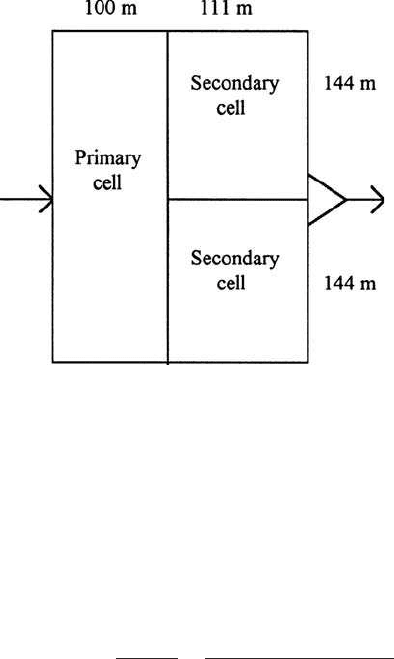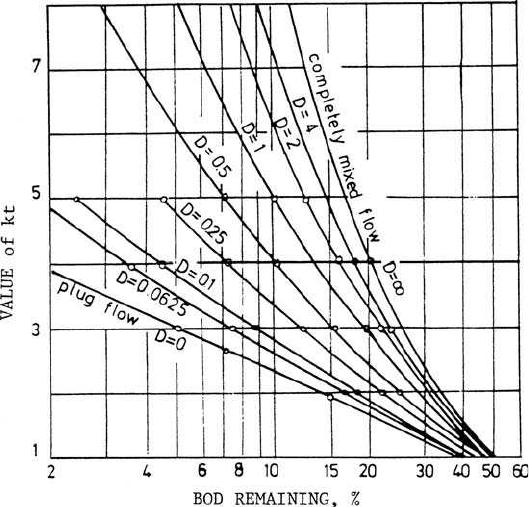Lin S.D. Water and Wastewater Calculations Manual
Подождите немного. Документ загружается.


Wastewater Engineering 725
Step 2. Compute the required surface area of the RBC
Step 3. Check the design for overall organic loading rate
It is under 2.0 [lbⲐ(1000 ft
2
⭈ d)], therefore OK.
Step 4. Size the first stage
The size factor for the area required for the first stage is 0.2 ⫻ SBOD load-
ing. For this case, the size factor is 0.346 (0.2 ⫻ 1.73, or 34.6% of total surface
area). This value can be obtained from the manufacturer’s curves.
Surface area for first stage ⫽ 0.346 ⫻ 1,160,000 ft
2
≅ 400,000 ft
2
Step 5. Determine configuration
(a) Choice standard media assemblies each having 100,000 ft
2
for the first
stage
Unit for first stage ⫽ 400,000 ft
2
/100,000 ft
2
⫽ 4
Use 4 standard media; each is installed at the first stage of 4 trains.
(b) Choice Hi-Density media assemblies have 150,000 ft
2
for the following
stages
High-Density media area ⫽ (1,160,000 ⫺ 400,000) ft
2
⫽ 760, 000 ft
2
No. of Hi-Density assemblies ⫽ 760,000 ft
2
/150,000 ft
2
⫽ 5.1
Alternative 1: Use 4 standard media at stages 2 and 3.
Alternative 2: Use 4 Hi-density media at stages 2 and 4 standard density
media at stage 3
Alternative 1 is less costly.
Alternative 2 has an advantage in preventing shock loadings.
5 1.73 [lb/s1000 ft
2
#
dd]
SBOD loading 5
4 Mgal/d 3 60 mg/L 3 8.34 lb/sMgal
#
mg/Ld
1.160,000 ft
2
5 1,160,000 ft
2
Area 5
4,000,000 gal/d
3.44 gal/sd
#
ft
2
d
726 Chapter 6
(c) Possible configurations are designed using 4 trains with 3 stages each, as
shown below:
(1) SSSS ⫹ SSSS ⫹ SSSS
or
(2) SSSS ⫹ HHHH ⫹ SSSS
Note:S ⫽ standard density media; H ⫽ high density media.
Step 6. Determine the required surface area for the secondary settling tank
(a) Compute surface area based on average (design) flow using an overflow
rate of 600 gal/(d ⭈ ft
2
)
Area ⫽ 4,000,000 (gal/d)/600 (gal/(d ⭈ ft
2
)
⫽ 6,670 ft
2
(b) Compute surface area based on peak flow using an overflow rate of
1200 gal/(d ⭈ ft
2
)
Area ⫽ 10,000,000 (gal/d)/1200 (gal/(d ⭈ ft
2
))
⫽ 8330 ft
2
(c) On the basis of the above calculations, the size of the secondary settling
tank is controlled by the maximum hourly flow rate.
24 Dual Biological Treatment
Dual biological treatment processes use a fixed film reactor in series with
a suspended growth reactor. Dual processes include such as activated
biofilter, trickling filter-solids contact, roughing filter-activated sludge,
biofilter-activated sludge, trickling filter-activated sludge, roughing
filter-RBC, roughing filter-aerated lagoon, roughing filter-facultative
lagoon, roughing filter-pure oxygen activated sludge. Descriptions of
these dual processes may be found elsewhere (Metcalf and Eddy, Inc.
1991; WEF and ASCE, 1991a).
25 Stabilization Ponds
The terms stabilization pond, lagoon, oxidation pond have been used syn-
onymously. This is a relatively shallow earthen basin used as second-
ary or tertiary wastewater treatment, especially in rural areas.
Stabilization ponds have been employed for treatment of wastewater for
over 300 years. Ponds have become popular in small communities
because of their low construction and operating costs. They are used to
treat a variety of wastewaters from domestic and industrial wastes and
functions under a wide range of weather conditions. Ponds can be
employed alone or in combination with other treatment processes.
Wastewater Engineering 727
Stabilization ponds can be classified as facultative (aerobic-anaerobic),
aerated, aerobic, and anaerobic ponds according to the dominant type
of biological activity or reactions occurring in the pond. Other classifi-
cations can be based on the types of the influent (untreated, screened,
settled effluent, or secondary (activated-sludge) effluent), the duration
of discharge (nonexistent, intermittent, and continuous), and the method
of oxygenation (photosynthesis, atmospheric surface reaeration, and
mechanical aeration). Aerated ponds (aerated lagoons) have been dis-
cussed previously.
25.1 Facultative ponds
The most common type of stabilization pond is the facultative pond. It
is also called the wastewater lagoon. Facultative ponds are usually
1.2 to 2.5 m (4 to 8 ft) in depth, with an aerobic layer overlying an anaer-
obic layer, often containing sludge deposits. The detention time is usually
5 to 30 days (US EPA, 1983b).
The ponds commonly receive no more pretreatment than screening
(few with primary effluent). It can also be used to follow trickling filters,
aerated ponds, or anaerobic ponds. They then store grit and heavy solids
in the first or primary ponds to form an anaerobic layer. The system is
a symbiotic relationship between heterotrophic bacteria and algae.
Bacteria found in an aerobic zone of a stabilization pond are prima-
rily of the same type as those found in an activated-sludge process or in
the zoogleal mass of a trickling filter. The most frequently isolated bac-
teria include Beggiatoa alba, Sphaerotilus natans, Achromobacter,
Alcaligenes, Flavobacterium, Pseudomonas, and Zoogloea spp. (Lynch
and Poole, 1979). These organisms decompose the organic materials
present in the aerobic zone into oxidized end products.
Organic matter in wastewater is decomposed by bacterial activities,
including both aerobic and anaerobic, which release phophorus, nitro-
gen, and carbon dioxide. Oxygen in the aerobic layer is supplied by sur-
face reaeration and algal photosynthesis. Algae consume nutrient and
carbon dioxide produced by bacteria and release oxygen to water. DO is
used by bacteria, thus forming a symbiotic cycle. In the pond bottom,
anaerobic breakdown of the solids in the sludge layer produces dis-
solved organics and gases such as methane, carbon dioxide, and hydro-
gen sulfide. Between the aerobic and anaerobic zones, there is a zone
called the facultative zone. Temperature is a major factor for the bio-
logical symbiotic activities.
Organic loading rates on stabilization ponds are expressed in terms
of kg BOD
5
applied per hectare of surface area per day (lb BOD/
(acre ⭈ d)), or sometimes as BOD equivalent population per unit area.
Typical organic loading rates are 22 to 67 kg BOD/(ha ⭈ d) (20 to 60 lb
BOD/(a ⭈ d)). Typical detention times range from 25 to 180 days. Typical

728 Chapter 6
TABLE 6.18 Recommended BOD
5
Loading Rates for Facultative Ponds
Water depth BOD loading rate
Average winter air
temperature, ⬚C m ft kg/(ha ⭈ d) lb/(acre ⭈ d)
<0 1.5–2.1 5–7 11–22 10–20
0–15 (59ºF) 1.2–1.8 4–6 22–45 20–40
>15 1.1 3.6 45–90 40–80
SOURCE: US EPA (1974b)
dimensions are 1.2 to 2.5 m (4 to 8 ft) deep with 4 to 60 ha (10 to 150 acres)
of surface area (US EPA, 1983b).
Facultative ponds are commonly designed to reduce BOD to about
30 mg/L; but, in practice, it ranges from 30 to 40 mg/L or greater due to
algae. Volatile organic removal is between 77% and 96%. Nitrogen
removal achieves 40% to 95%. Less phosphorus removal is observed,
being less than 40%. Effluent TSS levels range from 40 to 100 mg/L,
mainly contributed by algae (WEF and ASCE, 1991b). The presence of
algae in pond effluent is one of the most serious performance problems
associated with facultative ponds. The ponds are effective in removal of
fecal coliform (FC) due to their dying off. In most cases effluent FC den-
sities are less than the limit of 200 FC/100 ml.
Process design. Several design formulas with operational data were
presented in the design manual (US EPA, 1974b). Calculations of the size
of a facultative pond are also illustrated for the areal loading rate pro-
cedure, Gloyna equation, Marais–Shaw equation, plug-flow model, and
Wehner–Wilhelm equation. The design for partial-mix aerated lagoon is
given elsewhere (WPCF, 1990). In this section, design methods of the
areal loading rate method and the Wehner and Wilhelm model are
discussed.
Areal loading rate method. The design procedure is usually based on
organic loading rate and hydraulic residence time. Several empirical
and rational models for the design of facultative ponds have been pro-
posed. Several proposed design methods have been discussed elsewhere
(US EPA, 1983b). The areal loading rate is the most conservative design
method and can be adapted to specific standards. The recommended
BOD loading rates based on average winter air temperature are given
in Table 6.18 (US EPA , 1974b).
The surface area required for the facultative pond is determined by
dividing the organic (BOD) load by the appropriate BOD loading rate
listed in Table 6.18 or from the specific state standards. It can be

Wastewater Engineering 729
expressed as the following equation (as used for other processes):
(6.147)
(6.148)
where A ⫽ area required for facultative pond, ha or acre
BOD ⫽ BOD concentration in influent, mg/L
Q ⫽ flow of influent, m
3
/d or Mgal/d
LR ⫽ BOD loading rate for average winter air temperature,
kg/(ha ⭈ d) or lb/(acre ⭈ d)
1000 ⫽ conversion factor, 1000 g ⫽ l kg
8.34 ⫽ conversion factor, 1 Mgal ⭈ mg/L ⫽ 8.34 lb
The BOD loading rate at the first cell in a series of cells (ponds) should
not exceed 100 kg/(ha ⭈ d) (90 lb/(acre ⭈ d)) for warm climates, average
winter air temperature greater than 15⬚C (59⬚F), and 40 kg/(ha ⭈ d)
(36 lb/(acre ⭈ d)) for average winter air temperature less than 0⬚C (32⬚F).
Example 1: The design flow of facultative ponds for a small town is 1100 m
3
/d
(0.29 Mgal/d). The expected influent BOD is 210 mg/L. The average winter tem-
perature is 10⬚C (50⬚F). Design a three-cell system with organic loading less than
80 kg/(ha ⭈ d) (72 lb/(acre ⭈ d)) in the primary cell. Also estimate the hydraulic deten-
tion time when average sludge depth is 0.5 m and there are seepage and evapo-
ration losses of 2.0 mm of water per day.
solution:
Step 1. Determine area required for the total ponds
From Table 6.18, choose BOD loading rate LR ⫽ 38 kg/(ha ⭈ d) (33.9 lb/(acre ⭈ d)),
because mean air temperature is 10⬚C. Using Eq. (6.147)
Step 2. Determine the area required for the primary cell (use LR ⫽ 80 kg/
(ha ⭈ d))
5 2.80 shad
Area 5
1100 3 210
80 3 1000
5 60,800 m
2
5 6.08 ha s16.6 areasd
A 5
QsBODd
sLRds1000d
5
1100 m
3
/d 3 210 g/m
3
38 kg/sha
#
dd 3 1000 g/kg
A 5
QsBODds8.34d
sLRd
s British unitsd
A 5
QsBODd
sLRds1000d
sSI unitsd

730 Chapter 6
Step 3. Sizing for 3 cells
Referring to Table 6.18, choose water depth of 1.5 m (5 ft) for all cells.
(a) Primary cell:
Area ⫽ 2.88 ha ⫽ 28,800 m
2
Use 100-m (328-ft) wide, 288-m (945-ft) long and 1.5-m (5-ft) deep pond.
(b) Two other cells:
Area for each ⫽ (60,800 ⫺ 28,800) m
2
/2
⫽ 16,000 m
2
Choose 144 m in length, then the width ⫽ 111 m
The pond arrangements are as shown below.
Step 4. Estimate the hydraulic retention time
(a) Calculate the storage volume V (when average sludge depth ⫽ 0.5 m)
V ⫽ (1.5 m ⫺ 0.5 m) ⫻ 60,800 m
2
⫽ 60,800 m
3
(b) Calculate the water loss V ⬘
V⬘⫽0.002 m/d ⫻ 60,800 m
2
⫽ 122 m
3
/d
(c) Calculate the HRT storage time
5 62 days
HRT 5
V
Q 2 V r
5
60,800 m
2
1100 m
3
/d 2 122 m
3
/d

Wastewater Engineering 731
Example 2: A lagoon system contains two cells in series. Each cell is 110 m ⫻
220 m (360 ft ⫻ 720 ft) in size with a maximum operating depth of 1.64 m
(5.4 ft) and a minimum operating depth of 0.55 m. (1.8 ft). The wastewater
flow is 950 m
3
/d (0.25 MGD) with an average BOD
5
of 105 mg/L. Determine
the organic loading rate and the detention time of the lagoon. The tempera-
ture ranges 10 to 15⬚C.
solution:
Step 1. Calculate the BOD
5
loading rate
BOD
5
mass ⫽ 950 m
3
/d ⫻ 105 mg/L ⫻ 1000 L/m
3
⫻ 10
⫺6
kg/mg
⫽ 99.75 kg/d
Area of the primary cell ⫽ 110 m ⫻ 220 m
⫽ 24,200 m
2
⫻ 10
⫺4
ha/m
2
⫽ 2.42 ha
BOD
5
loading rate ⫽ (99.75 kg/d)/(2.42 ha)
⫽ 41.2 kg/(ha ⭈ d)
This loading rate is acceptable by checking with Table 6.18, at temperature
⬎15⬚C, the recommended BOD
5
loading rate ranges 22 to 45 kg/(ha ⭈ d).
Step 2. Calculate the detention time
The detention time ⫽ 24,000 m
2
/cell ⫻ (1.64 m ⫺ 0.55 m) ⫻ 2 cells ⫼ 950 m
3
/d
⫽ 55.5 days
Wehner and Wilhelm equation. Wehner and Wilhelm (1958) used the first-
order substrate removal rate equation for a reactor with an arbitrary
flow-through pattern, which is between a plug-flow pattern and a
complete-mix pattern. Their proposed equation is
(6.149)
where C ⫽ effluent substrate concentration, mg/L
C
0
⫽ influent substrate concentration, mg/L
a ⫽
k ⫽ first-order reaction constant, 1/h
t ⫽ detention time, h
D ⫽ dispersion factor⫽H/uL
H ⫽ axial dispersion coefficient, m
2
/h or ft
2
/h
u ⫽ fluid velocity, m/h or ft/h
L ⫽ length of travel path of a typical particle, m or ft
21 1 4ktD
C
C
0
5
4a exp s1/2Dd
s1 1 ad
2
expsa/2Dd 2 s1 2 ad
2
exps 2 a/2D d

732 Chapter 6
Figure 6.34 Relationship between kt values and percent BOD remaining
for various dispersions factors, by the Wehner-Wilhelm equation.
The Wehner-Wilhelm equation for arbitrary flow was proposed by
Thirumurthi (1969) as a method of designing facultative pond systems.
Thirumurthi developed a graph, shown in Fig. 6.34, to facilitate the use
of the equation. In Fig. 6.34, the term kt is plotted against the percent
BOD
5
remaining (C/C
0
) in the effluent for dispersion factors varying
from zero for an ideal plug-flow reactor to infinity for a complete-mix
reactor. Dispersion factors for stabilization ponds range from 0.1 to 2.0,
with most values not exceeding 1.0 due to the mixing requirement. Typical
values for the overall first-order BOD
5
removal rate constant k vary from
0.05 to 1.0 per day, depending on the operating and hydraulic character-
istics of the pond. The use of the arbitrary flow equation is complicated
in selecting k and D values. A value of 0.15 per day is recommended for
k
20
(US EPA, 1984). Temperature adjustment for k can be determined by
k
T
⫽ k
20
(1.09)
T ⫺ 20
(6.150)
where k
T
⫽ reaction rate at minimum operating water
temperature T, per day
k
20
⫽ reaction rate at 20⬚C, per day
T ⫽ minimum operating temperature, ⬚C
Wastewater Engineering 733
Example: Design a facultative pond system using the Wehner-Wilhelm
model and Thirumurthi application with the following given data.
Design flow rate Q ⫽ 1100 m
3
/d (0.29 Mgal/d)
Influent TSS ⫽ 220 mg/L
Influent BOD
5
⫽ 210 mg/L
Effluent BOD
5
⫽ 30 mg/L
Overall first-order k at 20⬚C ⫽ 0.22 per day
Pond dispersion factor D ⫽ 0.5
Water temperature at critical period ⫽ 1⬚C
Pond depth ⫽ 2 m (6.6 ft)
Effective depth ⫽ 1.5 m (5 ft)
solution:
Step 1. Calculate the percentage of BOD remaining in the effluent
C/C
0
⫽ 30 mg/L ⫻ 100%/(210 mg/L)
⫽ 14.3%
Step 2. Calculate the temperature adjustment for k
20
using Eq. (6.150)
k
T
⫽ k
20
(1.09)
T⫺20
⫽ 0.22 (1.09)
1⫺20
⫽ 0.043 (per day)
Step 3. Determine the value of k
T
t from Fig. 6.34
At C/C
0
⫽ 14.3% and D ⫽ 0.5
k
T
t ⫽ 3.1
Step 4. Calculate the detention time for the critical period of year
t ⫽ 3.1/(0.043 d
⫺1
)
⫽ 72 days
Step 5. Determine the pond volume and surface area requirements
Volume ⫽ Qt ⫽ 1100 m
3
/d ⫻ 72 days
⫽ 79,200 m
3
Area ⫽ volume/effective depth ⫽ 79,200 m
3
/1.5 m
⫽ 52,800 m
2
⫽ 5.28 ha
⫽ 13.0 acres

734 Chapter 6
Step 6. Check BOD
5
loading rate
Step 7. Determine the power requirement for the surface aerators
Assume that the oxygen transfer capacity of the aerators is twice the value
of the BOD applied per day and that a typical aerator has a transfer capacity
of 22 kg O
2
/(hp ⭈ d)
O
2
required ⫽ 2 ⫻ 1100 m
3
/d ⫻ 210(g/m
3
)/(1000 g/kg)
⫽ 462 kg/d
Power ⫽ (462 kg/d)/(22 kg/hp ⭈ d)
⫽ 21.0 hp
⫽ 15.7 kW
Use seven 3-hp units
Step 8. Check the power input to determine the degree of mixing
Power input ⫽ 15.7 kW/79.2 ⫻ 1000 m
3
⫽ 0.20 kW/1000 m
3
⫽ 0.0076 hp/1000 ft
3
Note: In practice, the minimum power input is about 28 to 54 kW/1000 m
3
(1.06 to 2.05 hp/1000 ft
3
) for mixing (Metcalf and Eddy, Inc. 1991).
Tertiary ponds. Tertiary ponds, also called polishing or maturation ponds,
serve as the third-stage process for effluent from activated-sludge or
trickling filter secondary clarifier effluent. They are also used as a second
stage following facultative ponds and are aerobic throughout their depth.
The water depth of the tertiary pond is usually 1 to1.5 m (3 to 4.5 ft).
BOD loading rates are less than 17 kg/(ha ⭈ d) (15 lb/(acre ⭈ d)). Detention
times are relatively short and vary from 4 to 15 days.
25.2 Aerobic ponds
Aerobic ponds, also referred to as high-rate aerobic ponds, are relatively
shallow with usual depths ranging from 0.3 to 0.6 m (1 to 2 ft), allowing
light to penetrate the full depth. The ponds maintain DO throughout their
entire depth. Mixing is often provided to expose all algae to sunlight and
to prevent deposition and subsequent anaerobic conditions. DO is supplied
by algal photosynthesis and surface reaeration. Aerobic bacteria utilize and
stabilize the organic waste. The HRT in the ponds is short—3 to 5 days.
5 40.0 lbsacre
#
dd
5 43.8 kg/sha
#
dd
Loading 5
1100 m
3
/d 3 210 g/m
3
5.28 ha 3 1000 g/kg
